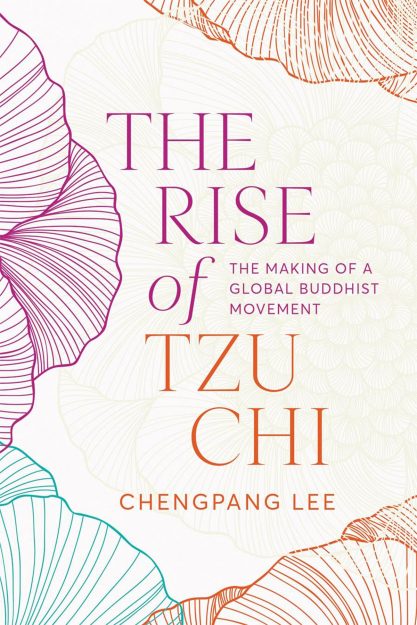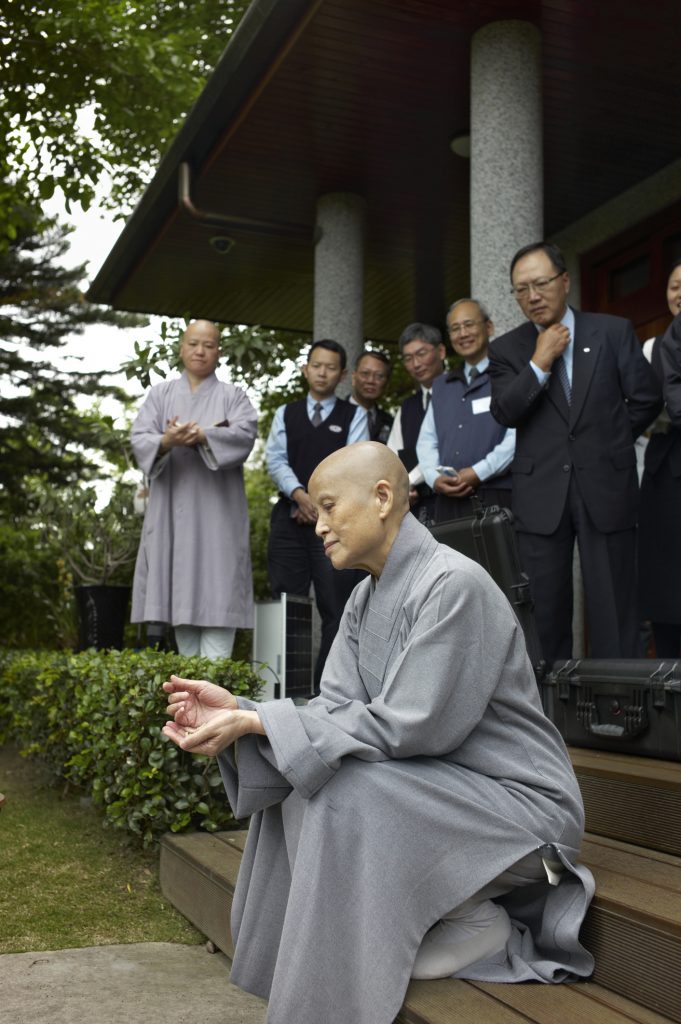In March of 2005, three months after a strong earthquake and tsunami devastated significant parts of Indonesia, Chengpang Lee joined a Taiwanese humanitarian delegation to visit Banda Aceh, a city on the northern tip of Sumatra, which had been severely affected. Upon arrival, the scene struck them: Hundreds of disaster relief tents were already set up, trucks filled with medical and food supplies moved steadily in and out, and uniformed volunteers efficiently assisted the displaced and injured. Tzu Chi had arrived ahead of them, creating an unforgettable impression of organized compassion amid chaos.
Now an assistant professor at Hong Kong Polytechnic University, Lee revisits this influential Buddhist humanitarian organization in his new book, The Rise of Tzu Chi: The Making of a Global Buddhist Movement. Lee traces the well-worn story of how Cheng Yen, a diminutive Buddhist nun known more for her charitable works than her scholarly learning, started a local charity with a small group of Taiwanese housewives, and charts the organization’s astonishing—and sometimes controversial—path to international prominence as a global nongovernmental organization.
Known throughout Taiwan and much of the Chinese-speaking world, Tzu Chi (Chinese for “compassionate relief”) has become a household name like no other Buddhist organization in East Asia. Initially founded in 1966 in Hualien as a mutual aid organization offering free medical treatment to people experiencing poverty, the organization has evolved into a major player in the world of international disaster relief and humanitarian assistance, becoming one of the first responders in the aftermath of the September 11 attacks, Hurricane Katrina, the 2008 Sichuan earthquake, and other recent natural disasters.
 The Rise of Tzu Chi: The Making of a Global Buddhist Movement
The Rise of Tzu Chi: The Making of a Global Buddhist Movementby Chengpang Lee
University of British Columbia Press, 2025, 256 pp., $37.95, paper
Cheng Yen (b. 1937) was born Wang Jinyun in Taichung County, the eldest daughter in a relatively well-off Taiwanese family. In 1958, her father died suddenly of a stroke. At 23, in shock from her first close encounter with death, she began visiting a local temple and prayed ceaselessly to Guanyin, the bodhisattva of compassion. Meeting an idealistic Buddhist nun inspired her to become a monastic herself. Eventually, they traveled along the eastern coast of Taiwan and decided to start a new Buddhist order there. She was ordained under Yin Shun (1906–2005), one of the leading intellectual figures in modern Chinese Buddhism, in what many believed to be a miraculous encounter. Soon after, she attracted her early followers, a dedicated group of Buddhist laywomen who became instrumental in raising money for charity.
After providing an overview of the early years, Lee looks at the development of Tzu Chi into a global powerhouse. By the end of the 1970s, Tzu Chi had widened its scope beyond Taiwan’s eastern coast and was in the process of building its first state-of-the-art hospital, marking the organization’s entry into a period of significant expansion. A new organizational structure was developed in 1990, integrating large numbers of medical and business professionals into leadership roles and heightening the organization’s presence by building hospitals, a medical school, a university, nursery schools, and even a pioneering bone marrow database. Tzu Chi then expanded beyond Taiwan’s borders, becoming a global organization that leveraged Taiwanese and overseas Chinese networks worldwide. Lee details Tzu Chi’s growth in the United States, particularly on the West Coast, and in four Southeast Asian countries—Indonesia, Malaysia, the Philippines, and Singapore—and how the organization eventually reached a combined worldwide membership of 10 million.
Tzu Chi is best understood in the context of its connection to humanistic Buddhism (renjian fojiao). A concept popularized by Cheng Yen’s teacher Yin Shun, humanistic Buddhism emphasizes active engagement with the secular world rather than renouncing it. Unlike Dharma Drum and Fo Guang Shan, two other purely religious international Buddhist organizations with roots in Taiwan, Tzu Chi’s charitable and humanitarian efforts are unique among its peers. Many of Cheng Yen’s followers, participating in this dual humanitarian and religious organization, have described being moved to tears by the sight of her or are inspired by her unwavering commitment to relieving suffering.
How can organizations sustain the vitality and purpose inspired by a charismatic founder after they are no longer present?
Lee notes that previous studies of Tzu Chi have generally focused on four aspects of its success: the charismatic leadership of Cheng Yen; the democratization and deregulation of religious activities in Taiwan in the late 1970s; its synthesis of Buddhism and Confucianism, which appealed to large segments of Taiwanese society; and the backing of Taiwan’s prevailing political party at the time, the Kuomintang (KMT), which contributed to the organization’s rapid growth. While Lee largely agrees with previous scholarship emphasizing Tzu Chi’s charismatic leadership and its political and cultural influences, he also underscores the organization’s distinctive geographical origins as significant.
One of the book’s unique features is the author’s analysis of Tzu Chi’s founding origins in Hualien, a major city along Taiwan’s eastern coast, and the geographical significance of the nearby mountains, creating the spatial conditions for Tzu Chi and other local associations to emerge. Drawing on scholars of the Chicago School, who argue that all human organizations are inevitably formed by their localities, Lee considers Hualien’s colonial legacy and the remnants of Japanese rule; the local religious ecology, in which Christian religious organizations dominated among the indigenous population; and Hualien’s propensity for natural disasters and the role of local newspapers in the emergence of an ethic of community activism. All of these are complex and intertwined factors that indelibly shaped Tzu Chi’s formation as an organization.
Lee also relies on leading community organizer Marshall Ganz’s “strategic capacity” framework to understand how an organization is shaped by its leader’s life experience, networks, repertoires of collective action, deliberative processes, resource flows, and so forth. He highlights the inherent tension between centralized power in a charismatic teacher and the push for organizational diversification, which challenges a single source of authority. According to Lee, Tzu Chi has navigated those competing demands nimbly, enabling it to be innovative and traditional, flexible and rigid, disciplined and spontaneous—seemingly contradictory qualities that coexist due to its high strategic capacity as an organization.

He does not shy away from critique either. Perhaps as a corollary to its growth and success in fundraising, Tzu Chi has over time received public criticism in Taiwan for various reasons: an incident between Cheng Yen and a private hospital that blew up in the media, a tainted cooking oil scandal, accusations of corruption and cozying up to mainland China because of its long-term humanitarian work there, and the Neihu Environmental Park development project that was eventually canceled. Lee also acknowledges the issues of leadership succession and restructuring the organization faces. Tzu Chi has transitioned to a typical nonprofit governance model, but its founder will not be easily replaced. Cheng Yen’s teachings and dharma talks permeate the organization, and no successor will be able to replicate her level of charismatic authority or institutional power.
In this sense, Tzu Chi’s challenges reflect broader questions facing contemporary Buddhist communities: How can organizations sustain the vitality and purpose inspired by a charismatic founder after they are no longer present? The Rise of Tzu Chi reminds Buddhist readers that beyond any individual’s charisma, an enduring Buddhist legacy lies in compassionate action, community engagement, and the structures built to support them. Perhaps Tzu Chi’s global impact invites us to reflect on our own roles within Buddhist practice: In the absence of visionary leaders, how might we ensure the ongoing vitality of our communities and the compassionate values they uphold?
Thank you for subscribing to Tricycle! As a nonprofit, we depend on readers like you to keep Buddhist teachings and practices widely available.
